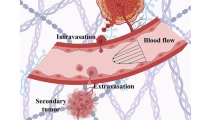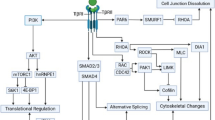Abstract
The treatment of ovarian cancer remains a medical challenge and its malignant progression is connected with obvious changes in both tissue and cell stiffness. However, the accurate mechanical-responsive molecules and mechanism remains unclear in ovarian cancer. Based on our previous results combined with the crucial regulatory role of STAT3 in the malignant progression of various cancer types, we want to investigate the relationship between STAT3 and matrix stiffness in ovarian cancer and further explore the potential mechanisms. Collagen-coated polyacrylamide gels (1, 6, and 60 kPa) were prepared to mimic soft or hard matrix stiffness. Western blotting, qRT-PCR, flow cytometry, IHC, EdU assays, and TEM were used to evaluate the effect of STAT3 in vitro under different matrix stiffnesses. Furthermore, a BALB/c nude mouse model was established to assess the relationship in vivo. Our results confirmed the differential expression of STAT3/p-STAT3 not only in normal and malignant ovarian tissues but also under different matrix stiffnesses. Furthermore, we verified that STAT3 was a mechanically responsive gene both in vitro and in vivo, and the mechanical response was carried out by altering the migration-related molecules (TNFAIP1) and adhesion-related molecules (LPXN, CNN3). The novel findings suggest that STAT3, a potential therapeutic target for clinical diagnosis and treatment, is a mechanically responsive gene that responds to matrix stiffness, particularly regulation in migration and adhesion in the progression of ovarian cancer.





Similar content being viewed by others
Data availability
The datasets used and/or analyzed during the current study are available from the corresponding author on reasonable request.
Abbreviations
- EOC:
-
Epithelial ovarian cancer
- KDST3:
-
Knockdown of STAT3
- FBS:
-
Fetal bovine serum
- PA gels:
-
Polyacrylamide gels
- FCM:
-
Flow cytometry
- TEM:
-
Transmission electron microscope
- GFP:
-
Green fluorescent protein
- Cytc:
-
Cytochrome C
- MMP2:
-
Matrix metalloproteinases 2
- LOX:
-
Lysyl oxidase
- VEGF:
-
Vascular endothelial growth factor
- HIF-1α:
-
Hypoxia-inducible factor-1α
- IL-6:
-
Interleukin-6
References
Xia C, Dong X, Li H, Cao M, Sun D, He S, Yang F, Yan X, Zhang S, Li N et al (2022) Cancer statistics in China and United States, 2022: profiles, trends, and determinants. Chin Med J 135(5):584–590
Sung H, Ferlay J, Siegel RL, Laversanne M, Soerjomataram I, Jemal A, Bray F (2021) Global cancer statistics 2020: GLOBOCAN estimates of incidence and mortality worldwide for 36 cancers in 185 countries. CA A Cancer J Clin 71(3):209–249
Siegel RL, Miller KD, Jemal A (2018) Cancer statistics, 2018. CA A Cancer J Clin 68(1):7–30
Wei X, Lou H, Zhou D, Jia Y, Li H, Huang Q, Ma J, Yang Z, Sun C, Meng Y et al (2021) TAGLN mediated stiffness-regulated ovarian cancer progression via RhoA/ROCK pathway. J Exp Clin Cancer Res 40(1):292
Choi JI, Park SB, Han BH, Kim YH, Lee YH, Park HJ, Lee ES (2016) Imaging features of complex solid and multicystic ovarian lesions: proposed algorithm for differential diagnosis. Clin Imaging 40(1):46–56
Xie M, Zhang X, Jia Z, Ren Y, Wang W (2014) Elastography, a sensitive tool for the evaluation of neoadjuvant chemotherapy in patients with high-grade serous ovarian carcinoma. Oncol Lett 8(4):1652–1656
Xie M, Zhang X, Zhan J, Hua K (2013) Application of real-time ultrasound elastography for discrimination of low- and high-grade serous ovarian carcinoma. J Ultrasound Med 32(2):257–262
Xu W, Mezencev R, Kim B, Wang L, McDonald J, Sulchek T (2012) Cell stiffness is a biomarker of the metastatic potential of ovarian cancer cells. PLoS ONE 7(10):e46609
Zhou ZL, Sun XX, Ma J, Tong MH, To SKY, Wong AST, Ngan AHW (2017) Actin cytoskeleton stiffness grades metastatic potential of ovarian carcinoma Hey A8 cells via nanoindentation mapping. J Biomech 60:219–226
Sun J, Luo Q, Liu L, Yang X, Zhu S, Song G (2017) Salinomycin attenuates liver cancer stem cell motility by enhancing cell stiffness and increasing F-actin formation via the FAK-ERK1/2 signalling pathway. Toxicology 384:1–10
Han Y, Wu J, Yang W, Wang D, Zhang T, Cheng M (2019) New STAT3-FOXL2 pathway and its function in cancer cells. BMC Mol Cell Biol 20(1):17
Zou S, Tong Q, Liu B, Huang W, Tian Y, Fu X (2020) Targeting STAT3 in cancer immunotherapy. Mol Cancer 19(1):145
Yang X, Wang G, Huang X, Cheng M, Han Y (2020) RNA-seq reveals the diverse effects of substrate stiffness on epidermal ovarian cancer cells. Aging 12(20):20493–20511
Sadrkhanloo M, Paskeh MDA, Hashemi M, Raesi R, Motahhary M, Saghari S, Sharifi L, Bokaie S, Mirzaei S, Entezari M et al (2023) STAT3 signaling in prostate cancer progression and therapy resistance: An oncogenic pathway with diverse functions. Biomed Pharmacother 158:114168
Ma JH, Qin L, Li X (2020) Role of STAT3 signaling pathway in breast cancer. Cell Commun Signal 18(1):33
He G, Karin M (2011) NF-κB and STAT3—key players in liver inflammation and cancer. Cell Res 21(1):159–168
Hu XM, Li ZX, Lin RH, Shan JQ, Yu QW, Wang RX, Liao LS, Yan WT, Wang Z, Shang L et al (2021) Guidelines for regulated cell death assays: a systematic summary, a categorical comparison, a prospective. Front Cell Dev Biol 9:634690
Burke PJ (2017) Mitochondria, bioenergetics and apoptosis in cancer. Trends Cancer 3(12):857–870
Hall A (2009) The cytoskeleton and cancer. Cancer Metastasis Rev 28(1–2):5–14
Hasan R, Zhou GL (2019) The cytoskeletal protein Cyclase-Associated Protein 1 (CAP1) in breast cancer: context-dependent roles in both the invasiveness and proliferation of cancer cells and underlying cell signals. Int J Mol Sci 20(11):2653
Kalli M, Li R, Mills GB, Stylianopoulos T, Zervantonakis IK (2022) Mechanical stress signaling in pancreatic cancer cells triggers p38 MAPK- and JNK-dependent cytoskeleton remodeling and promotes cell migration via Rac1/cdc42/Myosin II. Mol Cancer Res 20(3):485–497
Wang S, Basson MD (2009) Integrin-linked kinase: a multi-functional regulator modulating extracellular pressure-stimulated cancer cell adhesion through focal adhesion kinase and AKT. Cell Oncol 31(4):273–289
Yilmaz M, Christofori G (2010) Mechanisms of motility in metastasizing cells. Mol Cancer Res 8(5):629–642
Sasikumar S, Chameettachal S, Cromer B, Pati F, Kingshott P (2019) Decellularized extracellular matrix hydrogels-cell behavior as a function of matrix stiffness. Curr Opin Biomed Eng 10:123–133
Bregenzer ME, Horst EN, Mehta P, Novak CM, Repetto T, Mehta G (2019) The role of cancer stem cells and mechanical forces in ovarian cancer metastasis. Cancers 11(7):1008
Novak C, Horst E, Mehta G (2018) Review: Mechanotransduction in ovarian cancer: shearing into the unknown. APL Bioeng 2(3):031701
Laklai H, Miroshnikova YA, Pickup MW, Collisson EA, Kim GE, Barrett AS, Hill RC, Lakins JN, Schlaepfer DD, Mouw JK et al (2016) Genotype tunes pancreatic ductal adenocarcinoma tissue tension to induce matricellular fibrosis and tumor progression. Nat Med 22(5):497–505
Huang B, Lang X, Li X (2022) The role of IL-6/JAK2/STAT3 signaling pathway in cancers. Front Oncol 12:1023177
Li H, Qi Z, Niu Y, Yang Y, Li M, Pang Y, Liu M, Cheng X, Xu M, Wang Z (2021) FBP1 regulates proliferation, metastasis, and chemoresistance by participating in C-MYC/STAT3 signaling axis in ovarian cancer. Oncogene 40(40):5938–5949
Shodeinde AL, Barton BE (2012) Potential use of STAT3 inhibitors in targeted prostate cancer therapy: future prospects. Onco Targets Ther 5:119–125
Li S, Bai H, Chen X, Gong S, Xiao J, Li D, Li L, Jiang Y, Li T, Qin X et al (2020) Soft substrate promotes osteosarcoma cell self-renewal, differentiation, and drug resistance through miR-29b and Its target protein spin 1. ACS Biomater Sci Eng 6(10):5588–5598
Yang Y, Zheng H, Zhan Y, Fan S (2019) An emerging tumor invasion mechanism about the collective cell migration. Am J Transl Res 11(9):5301–5312
Zhang CL, Wang C, Yan WJ, Gao R, Li YH, Zhou XH (2014) Knockdown of TNFAIP1 inhibits growth and induces apoptosis in osteosarcoma cells through inhibition of the nuclear factor-κB pathway. Oncol Rep 32(3):1149–1155
Liu D, Wang X, Chen Z (2016) Tumor necrosis factor-α, a regulator and therapeutic agent on breast cancer. Curr Pharm Biotechnol 17(6):486–494
Wu Y, Zhou BP (2010) TNF-alpha/NF-kappaB/snail pathway in cancer cell migration and invasion. Br J Cancer 102(4):639–644
Tilghman RW, Parsons JT (2008) Focal adhesion kinase as a regulator of cell tension in the progression of cancer. Semin Cancer Biol 18(1):45–52
Schmidmaier R, Baumann P (2008) Anti-adhesion evolves to a promising therapeutic concept in oncology. Curr Med Chem 15(10):978–990
Gupta A, Lee BS, Khadeer MA, Tang Z, Chellaiah M, Abu-Amer Y, Goldknopf J, Hruska KA (2003) Leupaxin is a critical adaptor protein in the adhesion zone of the osteoclast. J Bone Miner Res 18(4):669–685
Sahu SN, Nunez S, Bai G, Gupta A (2007) Interaction of Pyk2 and PTP-PEST with leupaxin in prostate cancer cells. Am J Physiol Cell Physiol 292(6):C2288-2296
Hou T, Zhou L, Wang L, Kazobinka G, Chen Y, Zhang X, Chen Z (2018) Leupaxin promotes bladder cancer proliferation, metastasis, and angiogenesis through the PI3K/AKT pathway. Cell Physiol Biochem 47(6):2250–2260
Dai F, Luo F, Zhou R, Zhou Q, Xu J, Zhang Z, Xiao J, Song L (2020) Calponin 3 is associated with poor prognosis and regulates proliferation and metastasis in osteosarcoma. Aging 12(14):14037–14049
Acknowledgements
We thank the lab members for their in-depth discussions and careful reading of this manuscript.
Funding
The present study was supported by Youth Innovation Team of Shandong Province (2022KJ261), the Natural Science Foundation of Shandong Province (grant No. ZR2023MH193, ZR2019MH047, ZR2015HL057), and the National Natural Science Foundation of China (Grant number 81501683).
Author information
Authors and Affiliations
Contributions
Sun Chenchen performed the experiments and wrote the materials and results section. Zhang Hui and Bai Lanning helped Sun Chenchen finished some of experiments. Lu Yahui, Qian Xueqian, and Yuan Yi analyzed some of the data, and Qian Xueqian also made some revisions in the revised manuscript. Cheng Min provided the experimental instruments. Han Yang-yang designed all of the experiments and wrote the introduction and discussion section.
Corresponding author
Ethics declarations
Competing interests
The authors declare that they have no competing interests.
Ethical approval and consent to participate
Not applicable.
Consent for publication
Not applicable.
Additional information
Publisher's Note
Springer Nature remains neutral with regard to jurisdictional claims in published maps and institutional affiliations.
Supplementary Information
Below is the link to the electronic supplementary material.
Rights and permissions
Springer Nature or its licensor (e.g. a society or other partner) holds exclusive rights to this article under a publishing agreement with the author(s) or other rightsholder(s); author self-archiving of the accepted manuscript version of this article is solely governed by the terms of such publishing agreement and applicable law.
About this article
Cite this article
Chenchen, S., Xueqian, Q., Yahui, L. et al. STAT3 mediates ECM stiffness-dependent progression in ovarian cancer. Mol Cell Biochem (2024). https://doi.org/10.1007/s11010-024-04991-5
Received:
Accepted:
Published:
DOI: https://doi.org/10.1007/s11010-024-04991-5




